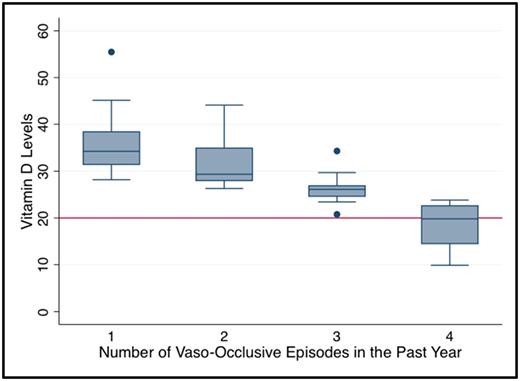Abstract

Background
Recent reports suggest that the clinical phenotype of sickle cell disease (SCD) in India may not be as mild compared to African haplotypes as previously believed (Jain et. al. 2016). There is however a paucity of data from India.There are some reports of association between Vitamin D deficiency and pain in SCD, but these associations have not been studied in pediatric SCD patients form India. The objective of this community-based study was to determine the frequency of vaso-occlusive episodes (VOE) in Indian pediatric SCD patients and to determine the relationship of Vitamin D deficiency to the frequencies of VOE and other SCD complications.
Methods
We conducted a community based study in aboriginal tribal area in Gadchiroli district in Maharashtra State, India. After providing informed consent, patients completed a health history interview and underwent blood testing for serum 25-Hydroxy Vitamin D by Radioimmunoassay. The number of times in the previous year that their child had severe pain, associated with cessation of activity including play and school attendance which required treatment, in the past year, was obtained by parent self-report, and was defined as a VOC. Hospitalizations for VOE treatment and number of blood transfusions in the past year were also obtained by parent self-report. No medical record review was done. Descriptive statistics and tests of hypothesis were performed using STATA Ver. 13.
Results
We screened 91 children (50% male) with a median age of 14 years (range 5-16, IQR 10-16). They reported a median 3 episodes of VOC/Year (IQR 2-4) and a median 2 Hospitalizations (IQR 1-2) and a median of 1 blood transfusion/ year (IQR 1-2). Median Vitamin D level was 26.4 (IQR 22.6-29.9) with 15 patients (16.5%) being Vitamin D deficient (<20ng/ml). On Student t-test with equal variance, Vitamin D deficient patients vs. Vitamin D replete patients revealed 4±0 vs. 2.5± 0.97 VOCs/year (p=0.0000), 2.3± 0.7 vs.1.60±0.7 (p=0.0006). Hospitalizations for VOC/year(P=0.010) and 1.9±0.7 vs 1.4 ±0.6 blood transfusions/year(P=0.0064). In a linear regression model, after adjusting for age and sex, higher vitamin D levels were associated with lower VOCs ( P=0.0000, Model F statistic= 53.8).
Conclusions
Children with SCD in an aboriginal tribal region in Gadchiroli, India have reported pain frequencies similar to that described in reports from other parts of the world. This suggests that the phenotype of SCD in India may not be as mild as previously thought. In this population, Vitamin D deficiency is associated with significantly increased VOE, hospitalizations for VOE and blood transfusions. These data provide the rationale for larger studies to further elucidate the association of Vitamin D with pain events in SCD, and to determine the causes of Vitamin D deficiency and its impact on severity of SCD, so as to inform the development of suitable preventive and therapeutic strategies
No relevant conflicts of interest to declare.
Author notes
Asterisk with author names denotes non-ASH members.

This icon denotes a clinically relevant abstract


